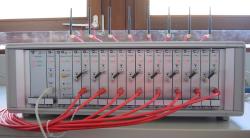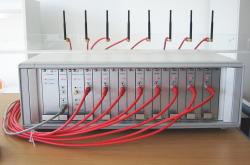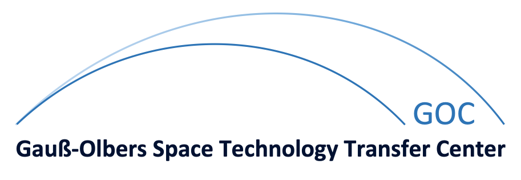MASI - Multiple Antenna System for ISM-Band Transmission
MASI system concept
MASI is our Multiple Antenna System for ISM-Band Transmission.
One motivation to built a MIMO hardware demonstrator is that the assumptions made about real channels may be incorrect, and the behavior of MIMO systems should be investigated under realistic conditions. Therefore it is sufficient to transmit and receive over a real channel and process the received data offline at the workstation environment. This basic idea roots in our single antenna system.
- transmission frequency in 2.4 GHz ISM-band
(5 MHz channel stepsize / 8 frequencies possible) - transmission power: +17 dBm (50 mW)
- direct conversion transmitter and receiver (AD 8346/8347)
- analog I/Q-bandwidth: +-16 MHz (depending on receive filters)
- 12 bit D/A converter (AD 9765)
- sampling frequencies: 10 MHz, 40 MHz, 50 MHz, PLL and external input
- maximum memory depth 512k (Tx) resp. 1024k (Rx) I/Q-samples
- PC connection (data and control) using the USB interface, supports Windows and Linux
- external connectors for the 2.4 GHz carrier frequency and 10MHz reference frequency
- control software for data transfers and settings (used memory depth, sampling frequency, automation of multiple measurements)
- binary file for each channel: alternating I/Q-samples as 16 bit integers
--> easy interfacing with Matlab or other tools
Some more detailed information can be found in the publications section.
We invite you...
We invite you and your institute to evaluate your MIMO (and SISO)-algorithms using our testbed.
You can send us your transmission file consisting of binary I/Q samples after digital impulse shaping, and we transmit it using our system....
Feel free to contact us for further information: Henning Paul.
Details
| Duration: | 07/2002 - 09/2011 |
| Funding: | ANT |
| Subsequent: | Software Defined Radio Demonstrators |
Publications
-
An Enhanced MIMO Hardware Demonstrator - Polarization Diversity in Adaptive OFDM Systems
BibTEX

M. Petermann, M. Stefer, D. Wübben, M. Schneider, K.-D. Kammeyer
15th International OFDM-Workshop (InOWo 10), Hamburg, Germany, 1. - 2. September 2010 -
Iterative Pre-Compensation of I/Q Imbalances in an Adaptive 2.4 GHz MIMO-OFDM System
BibTEX

M. Petermann, M. Niemiec, D. Wübben, K.-D. Kammeyer, M. Stefer, M. Schneider
International ITG Workshop on Smart Antennas (WSA 2010), Bremen, Germany, 23. - 24. February 2010 -
Influence of Non-reciprocal Transceivers at 2.4 GHz in Adaptive MIMO-OFDM Systems
BibTEX

M. Stefer, M. Petermann, M. Schneider, D. Wübben, K.-D. Kammeyer
14th International OFDM-Workshop 2009 (InOWo 09), Hamburg, Germany, 2. - 3. September 2009 -
A Multiple-Antenna System for ISM Band Transmission - Calibration Issues and Eigenbeam Measurements
BibTEX


M. Petermann, H. Paul, D. Wübben, K.-D. Kammeyer
13th International OFDM-Workshop 2008 (InOWo 08), Hamburg, Germany, 27. - 28. August 2008 -
A Multiple-Antenna System for ISM-Band Transmission
BibTEX


J. Rinas, R. Seeger, L. Brötje, S. Vogeler, T. Haase, K.-D. Kammeyer
EURASIP Journal on Applied Signal Processing, No. 9, pp. 1407-1419, August 2004 -
A MIMO Hardware Demonstrator: Application of Space-Time Block Codes
BibTEX


R. Seeger, L. Brötje, K.-D. Kammeyer
IEEE Symposium on Signal Processing and Information Technology (ISSPIT 03), Darmstadt, Germany, 14. - 17. December 2003 -
MIMO Measurements of Communication Signals and Application of Blind Source Separation
BibTEX



J. Rinas, K.-D. Kammeyer
IEEE International Symposium on Signal Processing and Information Technology (ISSPIT 2003), Darmstadt, Germany, 14. - 17. December 2003 -
A Hardware Demonstrator for MIMO-Communication Systems: Application to Blind Source Separation
BibTEX

J. Rinas, A. Scherb, T. Haase, K.-D. Kammeyer
European Summer School on ICA - from Theory to Applications, Berlin, Germany, 16. June 2003









